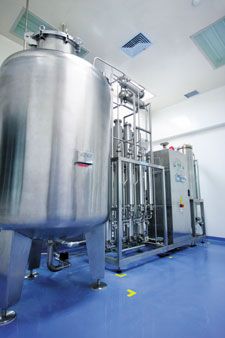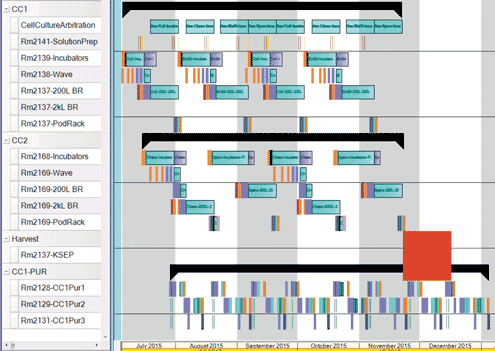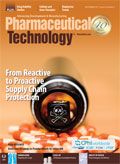Using Simulation to Address Capacity Limitations
Modeling tools help process engineers optimize a biopharmaceutical facility’s capacity.
Hywit Dimyadi/shutterstock.com

Biologics manufacturing facilities are highly complex, often supporting multiple products with 10–15 batch-mode unit operations. As biotech companies’ pipelines mature into a stream of commercial products, there is generally a financial benefit to utilizing an existing facility to meet production demands rather than building a new facility, and over time, many facilities are pushed up to or beyond the capabilities envisioned during initial construction.
In nearly all cases, pushing a biologics manufacturing facility to its capacity limit and/or expanding capacity generates a number of complex questions that must be answered before successfully delivering a capacity increase. Often, plants don’t have a clear and obvious bottleneck, and the capacity may be limited by a series of steps across many pieces of equipment, such as turnaround of a buffer storage tank at one point in a process, a brief delay for an ultrafiltration-diafiltration (UFDF) setup step, and then a delay in which a series of clean-in-place (CIP) activities are limiting. Additionally, these complex “critical path” sequences are typically product dependent.
Plant simulation is a powerful modeling discipline that compiles a facility’s equipment and resource model with a process execution recipe to aid process engineers in understanding a plant’s capacity and in investigating how potential investments or operational changes might affect the capacity. A number of commercially available tools are currently available, and here, the authors present the application of one tool (VirtECS, Advanced Process Combinatorics) to address capacity challenges of a biologics contract manufacturer, KBI Biopharma. Case studies address an opportunistic (i.e., low budget) debottlenecking effort, support of scope development for a capacity-focused capital project, and routine scheduling to support response to unplanned delays and events.
Simulation technology
The case studies discussed here were implemented using VirtECS version 8.1.8-Biologics, which addresses scheduling, planning, and analysis problems using the Resource Task Network (RTN), a computing language for process scheduling (1). Within the RTN, the cell-culture facility, mainline manufacturing, buffer, media, cleaning, utility areas, and other equipment are described as a set of tasks that consume input materials at a time relative to the start time of the activity and produce output materials, such as inoculum, fermentation product, media, and purification buffers. Tasks occupy one or more pieces of equipment and can also utilize specified amounts of labor or other shared resources for defined time intervals as part of a schedule. Materials are tracked and occupy storage tanks, totes, or process vessels as appropriate. The software accounts for all real-world constraints of the cell-culture facility including limited storage and labor capacities.
The RTN is the inclusive collection of all the modeled materials (including buffers and media), activities (including CIP, buffer prep, and media prep), and renewable resources (e.g., shared utilities). It describes the essential physics of the plant. The RTN is general and able to describe scheduling problems across a variety of industries, but it is used here under a data schema tailored to biologics manufacturing that enables manipulation of low-level RTN components via specification of high-level concepts (e.g., executing a cell-culture step or preparing a buffer).
Once the process data are entered, a schedule can be calculated in the form of a Gantt chart, with corresponding material and resource inventory plots and reports. The timing of each task in the scheduling solution is determined by an underlying mixed integer linear programming (MILP) solver using a specialized mathematical formulation that is automatically generated from the RTN (2). This mathematical formulation divides time up into small slices and enforces material balance constraints, storage limitations, and other basic physics (e.g., only one activity can be performed on any equipment at one time). This approach prevents over-assignment of equipment, storage capacity, or other shared resources while maintaining all material balances to ensure the feasibility of the resulting optimized schedule.
This advanced, mathematically grounded approach has many advantages over older technologies including solution speed, ease of use, and high fidelity to process detail. A typical schedule calculation time for a six-month production scenario in a large-scale cell-culture facility is about three minutes using a standard personal computer. Using plant simulation tools, process engineers and plant schedulers can analyze many schedule instances involving demand uncertainty, process duration distributions, or changes in process parameters against a base case to understand the effect of forecast uncertainty or proposed engineering changes (3, 4) as discussed in the following case studies.
Case study one: cell-culture facility debottlenecking
In the first case study, plant simulation was applied to debottlenecking a KBI cell-culture facility. The key challenge was that the company had an opportunity to book additional projects, but required a deeper understanding of the facility capability to commit to additional production. Plant simulation was employed to determine how the facility could increase utilization of its existing production bioreactors.
The initial activity in a debottlenecking exercise should always be to document the current operational assumptions, to build a base case model, and to verify that the base case accurately reflects the real facility. In the base-case model, four diverse products were chosen to represent a typical product mix in a scenario of eight production lots; changing products between each lot as is typical for this facility. The selected product recipes captured typical variations seen across products. The flask stages, seed train, and production reactor durations varied. One product did not utilize the wave reactor and had a long occupancy of the inoculum growth area. The processes had less variation in terms of downstream sequence (typical three-column downstream process ending with a combination of UFDF, viral filtration, and bulk container filling), but the column loadings and volumes in downstream varied and provided a realistic level of process duration variation.
For the KBI mammalian cell-culture model, processing rooms were chosen to populate an “equipment” model rather than the more common practice of modeling specific tanks and process skids. For this facility, allocation of the process areas more effectively describes constraints within and between lots because one room may host multiple process steps, but only one step at a time. Other key features modeled include changeover between lots, allocation of labor, a labor availability calendar, setup tasks, and valid connectivity paths for upstream. Media and buffer were not a major part of the model because the facility relied on outsourced solution prep and disposable containers at this time, and was rarely or not limited by solution prep or storage.
Analysis of the base-case Gantt chart shown in Figure 1 indicated that at a target run rate of 12 days per lot, upstream is unconstrained, but downstream is unable to keep up. The red box indicates the delay between upstream completion of the final lot and continuation of downstream for that lot. By the end of the eighth upstream production reactor step, two harvest pools are awaiting purification. Each cluster of tasks on Rm2128 represents initial purification, and each long cyan block on either RM2137 or RM2169 represents a production reactor step. Another key observation from the base-case scenario was that although purification is clearly not keeping up, the purification area is frequently idle due to the purification staffing hours, which were modeled using a resource availability calendar.
Figure 1: Durham facility base-case capacity for debottlenecking simulation. All figures are courtesy of the authors.

Generation of the base-case model immediately clarified the facility’s challenges and explained why there were differing viewpoints on the facility capacity. Using the base-case plant simulation output and a variety of alternative scenarios, a plan was developed to increase staffing and implement operational efficiency improvements identified by the plant simulation exercise to support a capacity increase. Once the purification staffing was increased, the model identified the next key bottlenecks as the inoculum laboratory and allocation of purification rooms for column packing between lots. A variety of alternatives were evaluated using plant simulation scenarios such as relocation of the wave reactor, elimination of backup flask cultures, and reconfiguration of purification equipment locations.
After combining the plant simulation scenario capacity forecasts with an assessment of cost, process risk, and business risk, the best scenario was implemented over a one year ramp-up period, and the facility increased capacity by about 60% with minimal investment of capital.
Case study two: capital project scope and alternatives analysis
The second case study demonstrates how plant simulation supported the decision-making process for capital project scoping in the KBI fermentation facility, where a capacity limit meant the facility might have to forego additional revenue opportunities. Traditionally, biotech manufacturing facility capital projects have poor track records of achieving targeted capacity levels. Reasons for performance shortfalls vary, but a common theme is that rules of thumb, back-of-the-envelope calculations, and survey and consensus-based approaches are insufficient and frequently overlook key opportunities and constraints for complex biotech facilities. Capacity-related capital projects for biotech manufacturing are typically in the millions to tens of millions of dollars range, and failure to deliver on expected performance is costly.
In this case, the facility’s primary limitation was clearly the single chromatography skid utilized for multiple steps within each production lot. Figure 2 shows the repeated use of equipment CH-509-001 within one production lot (outlined in the red box at the bottom of the figure). However, the best investment choice and full scope to alleviate the limitation were not well understood. Plant simulation was used to investigate two key questions:
- Is additional equipment beyond the chromatography skid needed to improve capacity such as buffer prep, buffer storage, or additional water-for-injection supply?
- Would use of an additional manufacturing area (already underway for other purposes) enable the facility to deliver higher capacity?
Figure 2: Capital project alternatives: base-case scenario.

The base-case and two alternative scenarios were developed to forecast capacity under each scenario. The fermentation facility model contains a significantly larger number of equipment entities than the cell-culture model, because solutions are prepared on site, constraints tend to be related to specific equipment rather than rooms, and the facility has many fixed storage tanks that are temporarily rate limiting at various periods of production. Analysis of the base-case Gantt chart confirmed that the capacity limit of the facility was driven by allocation of the single chromatography skid (CH-509, outlined in the red box at the bottom of Figure 2) multiple times per lot. However, after relaxing that constraint by adding another skid to the model, it was apparent that the buffer preparation and storage would also require additional equipment to increase capacity. In this case, explicit modeling of buffer storage (allocating the storage tank from the point a buffer is transferred in until it is fully consumed by the process) was a critical set of constraints necessary to accurately model the facility.
Both investment options (chromatography skid plus buffer storage and utilizing an additional suite for final purification steps) increased the capacity by 14%. Ultimately, the additional skid and buffer storage option was selected because the new downstream suite had other high value uses planned and therefore incurred a high opportunity cost. The key contribution of plant simulation in this project was identification of the minimal set of additional buffer storage necessary to realize a capacity increase from investment in a second chromatography skid.
Case study three: fermentation facility scheduling
The third case study shows how plant simulation can be used for finite scheduling and can deliver automated constraint resolution to support coordination of manufacturing floor activities. By linking labor resource needs to each task, the facility was able to generate a more consistent and supportable initial schedule.
Using the plant simulation tool for scheduling enabled accurate accounting for buffer storage tank allocation for cases in which multiple solutions are assigned to different tanks. For example, during the initial trial (while still running under the scheduling toolset used prior to VirtECS), a one-day discrepancy between the tools’ forecasted lot completion times was identified and traced to a missed buffer storage constraint in the older scheduling tool. Because there was no concept of material storage in the prior scheduling toolset, there was an ongoing risk of scheduling storage of more than one buffer at a time in a tank. As shown in Figure 3, the correct handling of buffer storage allocates the storage tank (T707 in this case) from the time Buffer A is transferred to it until the time Buffer A is fully consumed or disposed of; allowing for accurate representation of a changeover of the tank and storage of Buffer B later in the process. The linkage between the storage task duration and the timing of creation and consumption of buffer is important to ensure the model accurately reflects the real-world constraint on allocation and cleaning of buffer storage tanks.
Figure 3: Example of using plant simulation to examine buffer storage constraints.

As in the previous case studies, scheduling requires a wide variety of model constraints; however, it’s also necessary to be able to accommodate an on-the-fly change in timing or duration of a task and recalculate or re-optimize the future from that point on to account for the fact that real-world execution will eventually deviate from the initial scheduling plan. Plant simulation creates the ability to quickly generate a schedule or explore a potential schedule change. For example, after an unexpected delay on the floor, a schedule revision was needed, but the next step’s start time was dependent on completion of a quality control sample analysis. The expected scenario was generated in about 30 minutes, and an alternative schedule was prepared in advance in case the sample results were completed early.
Conclusion
Plant simulation is a powerful modeling approach that can deliver answers to complex biotech capacity questions. Many biotech companies are already employing plant simulation tools; however, significant opportunity remains within the biotech industry to expand use in support of capital project scoping, facility debottlenecking, and facility scheduling.
References
1. M. Zentner, A. Elkamel, J. Pekny, and G. V. Reklaitis, Computers and Chemical Engineering, 22 (1-2) 125-145 (1998).
2. J. F. Pekny, Computers and Chemical Engineering 26 (2) 239-267 (2002).
3. D. Miller, D. Schertz, C. Stevens, and J. Pekny, BioPharm Int. 23 (2) 26-38 (2010).
4. D. Miller, D. Schertz, C. Stevens, and J. Pekny, BioPharm Int. 23 (3) 40-52 (2010).
Article Details
Pharmaceutical Technology
Vol. 41, No. 9
Pages: 52–56
Citation
When referring to this article, please cite it as J. Robinson, S. Miller, L. Baxter, S. Hunt, B. Todd, and J. Pekny, " Using Simulation to Address Capacity Limitations," Pharmaceutical Technology 41 (9) 2017.
About the authors
John Robinson was previously Principal Engineer at KBI Biopharma; Spencer Miller is Senior Engineer and Laurence T. Baxter is vice-president of R&D, both at Advanced Process Combinatorics, West Lafayette, IN, www.combination.com; Stephen Hunt* is director of Process Engineering at KBI BioPharma, shunt@kbibiopharma.com; Bob Todd is vice-president of Process Development at KBI BioPharma; and Joseph F. Pekny is cofounder of Advanced Process Combinatorics, Inc. and professor of Chemical Engineering at Purdue University.
*To whom correspondence should be addressed.

Pharmaceutical Tariffs Are Imminent: How Industry is Bracing for Impact
April 16th 2025On April 14, 2025, the Trump Administration launched a national security-driven investigation into pharmaceuticals, a move that will likely result in tariffs being placed on pharmaceutical drugs, ingredients, and other components that are imported from outside of the United States.
Drug Solutions Podcast: A Closer Look at mRNA in Oncology and Vaccines
April 30th 2024In this episode fo the Drug Solutions Podcast, etherna’s vice-president of Technology and Innovation, Stefaan De Koker, discusses the merits and challenges of using mRNA as the foundation for therapeutics in oncology as well as for vaccines.